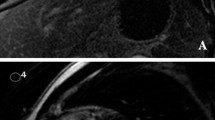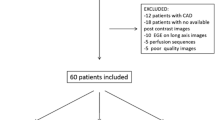Abstract
Background
The presence of myocardial fibrosis is associated with adverse outcome in dilated cardiomyopathy (DCM). Delayed contrast-enhanced cardiac magnetic resonance (DE-CMR) currently represents the gold standard in noninvasive evaluation of myocardial scarring. However, a significant number of patients are unable to undergo DE-CMR study for various reasons. We sought to determine the diagnostic accuracy of cardiac CT (CCT) compared with CMR in the investigation of the presence of delayed contrast enhancement (DCE) in subjects with DCM.
Methods
We prospectively enrolled 17 consecutive patients with DCM, who were initially referred to our institution because of recently manifested heart failure due to unexplained left ventricular systolic dysfunction. In all subjects, CCT and DE-CMR were performed within 1 week.
Results
CCT and DE-CMR showed satisfactory agreement in detecting DCE (agreement in 82% cases, κ = 0.56) with 50% sensitivity, 100% specificity, and a positive predictive value of 100%.
Conclusion
CCT may be a valuable method for detecting DCE in patients with DCM. CCT thus might be considered as an alternative method to DE-CMR in the assessment of the presence and extent of myocardial fibrosis in subjects who are not suitable for DE-CMR examination.
Zusammenfassung
Hintergrund
Eine Myokardfibrose geht bei dilatativer Kardiomyopathie („dilated cardiomyopathy“, DCM) mit einem ungünstigen Verlauf einher. Dabei stellt die kardiale Magnetresonanztomographie mit verzögerter Kontrastverstärkung („delayed contrast enhanced cardiac magnetic resonance“, DE-CMR) derzeit den Goldstandard zur nichtinvasiven Beurteilung der myokardialen Vernarbung dar. Jedoch kann bei einer beträchtlichen Anzahl Patienten aus verschiedenen Gründen keine DE-CMR-Untersuchung durchgeführt werden. Ziel der Autoren war es, die diagnostische Genauigkeit der kardialen Computertomographie (CCT) bei der Beurteilung des Vorliegens einer verzögerten Kontrastverstärkung („delayed contrast enhancement“, DCE) bei Patienten mit DCM im Vergleich zur CMR zu ermitteln.
Methoden
Prospektiv wurden 17 konsekutive Patienten mit DCM in die Studie aufgenommen, die initial wegen einer kurz zuvor manifest gewordenen Herzinsuffizienz aufgrund linksventrikulärer systolischer Dysfunktion unklarer Genese an die Klinik der Autoren überwiesen worden waren. Bei allen Teilnehmern wurden die CCT und die DE-CMR innerhalb einer Woche durchgeführt.
Ergebnisse
CCT und DE-CMR wiesen eine befriedigende Übereinstimmung in der Erkennung der DCE auf (Übereinstimmung in 82 % der Fälle, kappa: 0,56) bei einer Sensitivität von 50 %, einer Spezifität von 100 % und einem positiven prädiktiven Wert von 100 %.
Schlussfolgerung
Die CCT stellt möglicherweise eine nützliche Methode zur Erkennung der DCE bei Patienten mit DCM dar. Daher könnte die CCT als Alternativverfahren zur DE-CMR in Betracht gezogen werden, um das Vorliegen und das Ausmaß einer Myokardfibrose bei Patienten zu beurteilen, die sich nicht für eine DE-CMR-Untersuchung eignen.

Similar content being viewed by others
References
Elliott P, Andersson B, Arbustini E et al (2008) Classification of the cardiomyopathies: a position statement from the European Society of Cardiology Working Group on Myocardial and Pericardial Diseases. Eur Heart J 29:270–276
Assomull RG, Prasad SK, Lyne J, Smith G et al (2006) Cardiovascular magnetic resonance, fibrosis, and prognosis in dilated cardiomyopathy. J Am Coll Cardiol 48:1977–1985
Scott PA, Rosengarten JA, Curzen NP, Morgan JM (2013) Late gadolinium enhancement cardiac magnetic resonance imaging for the prediction of ventricular tachyarrhythmic events: a meta-analysis. Eur J Heart Fail 15:1019–1027
Kuruvilla S, Adenaw N, Katwal AB, Lipinski MJ et al (2014) Late gadolinium enhancement on cardiac magnetic resonance predicts adverse cardiovascular outcomes in nonischemic cardiomyopathy: a systematic review and meta-analysis. Circ Cardiovasc Imaging 7:250–258
Zhao L, Ma X, DeLano MC et al (2012) Assessment of myocardial fibrosis and coronary arteries in hypertrophic cardiomyopathy using combined arterial and delayed enhanced CT: comparison with MR and coronary angiography. Eur Radiol 23:1034–1043
Zhao L, Ma X, Feuchtner GM et al (2014) Quantification of myocardial delayed enhancement and wall thickness in hypertrophic cardiomyopathy: Multidetector computed tomography versus magnetic resonance imaging. European. J Radiol 83:1778–1785
Zhao L, Ma X, Ge H et al (2014) Diagnostic performance of computed tomography for detection of concomitant coronary disease in hypertrophic cardiomyopathy. Eur Radiol 25:767–775
Nieman K, Shapiro MD, Ferencik M et al (2008) Reperfused Myocardial Infarction: Contrast-enhanced 64-Section CT in Comparison to MR Imaging. Radiology 247:49–56
Wichmann JL, Arbaciauskaite R, Kerl JM, Frellesen C et al (2014) Evaluation of monoenergetic late iodine enhancement dual-energy computed tomography for imaging of chronic myocardial infarction. Eur Radiol 24:1211–1218
Esposito A, Palmisano A, Antunes S, Maccabelli G et al (2016) Cardiac CT with delayed enhancement in the characterization of ventricular tachycardia structural substrate: relationship between CT-segmented scar and electro-anatomic mapping. JACC Cardiovasc Imaging 9:822–832
Lang RM, Bierig M, Devereux RB, Flachskampf FA, Chamber Quantification Writing Group, American Society of Echocardiography’s Guidelines and Standards Committee, European Association of Echocardiography (2005) Recommendations for chamber quantification: a report from the American Society of Echocardiography’s Guidelines and Standards Committee and the Chamber Quantification Writing Group, developed in conjunction with the European Association of Echocardiography, a branch of the European Society of Cardiology. J Am Soc Echocardiogr 18:1440–1463
ICRP (2007) The 2007 recommendations of the international commission on radiological protection. Ann ICRP 37:1–332
Altman DG (1990) Practical statistics for medical research. CRC Press, Boca Raton
Simonetti OP, Kim RJ, Fieno JM et al (2001) An improved MR imaging technique for the visualization of myocardial infarction. Radiology 218:215–223
Ketelsen D, Buchgeister M, Korn A et al (2012) High-pitch computed tomography coronary angiography – a new dose-saving algorithm: estimation of radiation exposure. Radiology Res Pract 2012:e724129
Greupner J, Zimmermann E, Grohmann A, Dübel HP et al (2012) Head-to-head comparison of left ventricular function assessment with 64-row computed tomography, biplane left cineventriculography, and both 2‑ and 3‑dimensional transthoracic echocardiography: comparison with magnetic resonance imaging as the reference standard. J Am Coll Cardiol 59:1897–1907
Koyama Y, Matsuoka H, Mochizuki T et al (2005) Assessment of reperfused acute myocardial infarction with two-phase contrast-enhanced helical CT: prediction of left ventricular function and wall thickness. Radiology 235:804–811
Gleeson TG, Bulugahapitiya S (2004) Contrast-induced nephropathy. Am J Roentgenol 183:1673–1689
Acknowledgements
The project was supported by PRVOUK-P35/LF1/5, Project reg. no. CZ.2.16/3.1.00/24012 from OP Prague Competitiveness.
Author information
Authors and Affiliations
Corresponding author
Ethics declarations
Conflict of interest
V. Cerny, P. Kuchynka, J. Marek, L. Lambert, M. Masek, T. Palecek, D. Ambroz, A. Linhart, and J. Danes declare that they have no competing interests.
Rights and permissions
About this article
Cite this article
Cerny, V., Kuchynka, P., Marek, J. et al. Utility of cardiac CT for evaluating delayed contrast enhancement in dilated cardiomyopathy. Herz 42, 776–780 (2017). https://doi.org/10.1007/s00059-016-4515-4
Received:
Accepted:
Published:
Issue Date:
DOI: https://doi.org/10.1007/s00059-016-4515-4
Keywords
- Computed tomography
- Magnetic resonance imaging
- Delayed contrast enhancement
- Myocardial fibrosis
- Dilated cardiomyopathy




